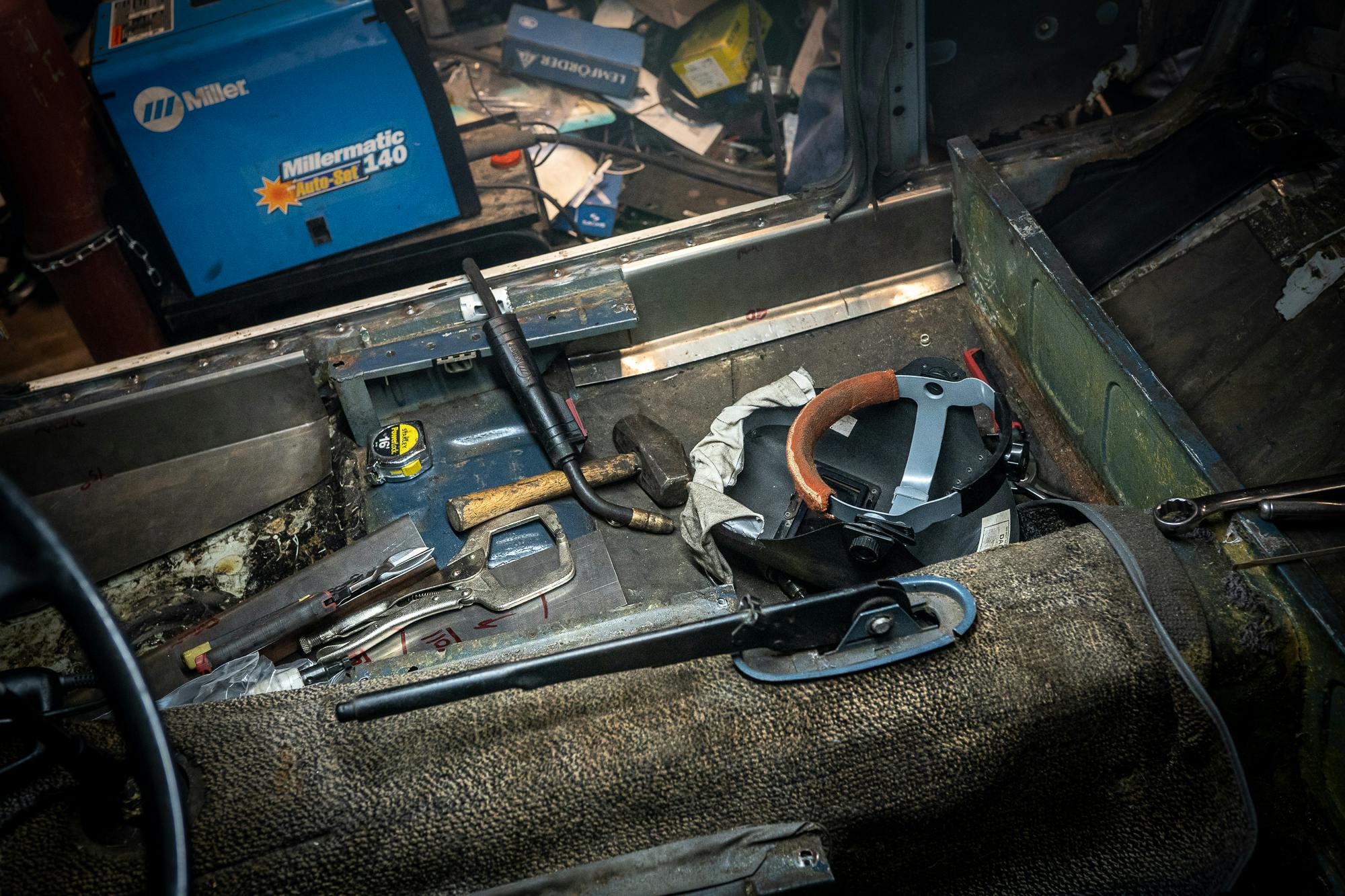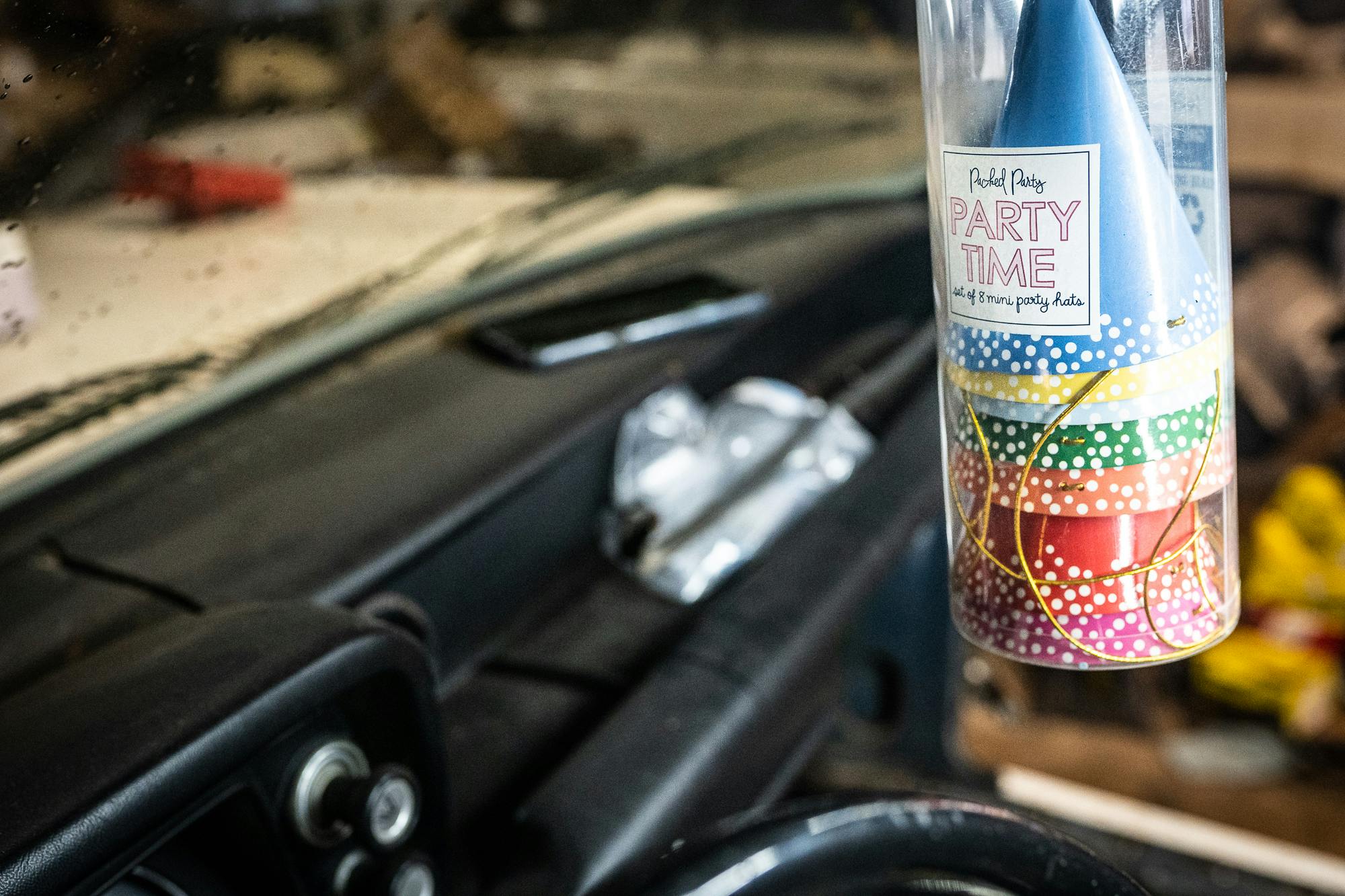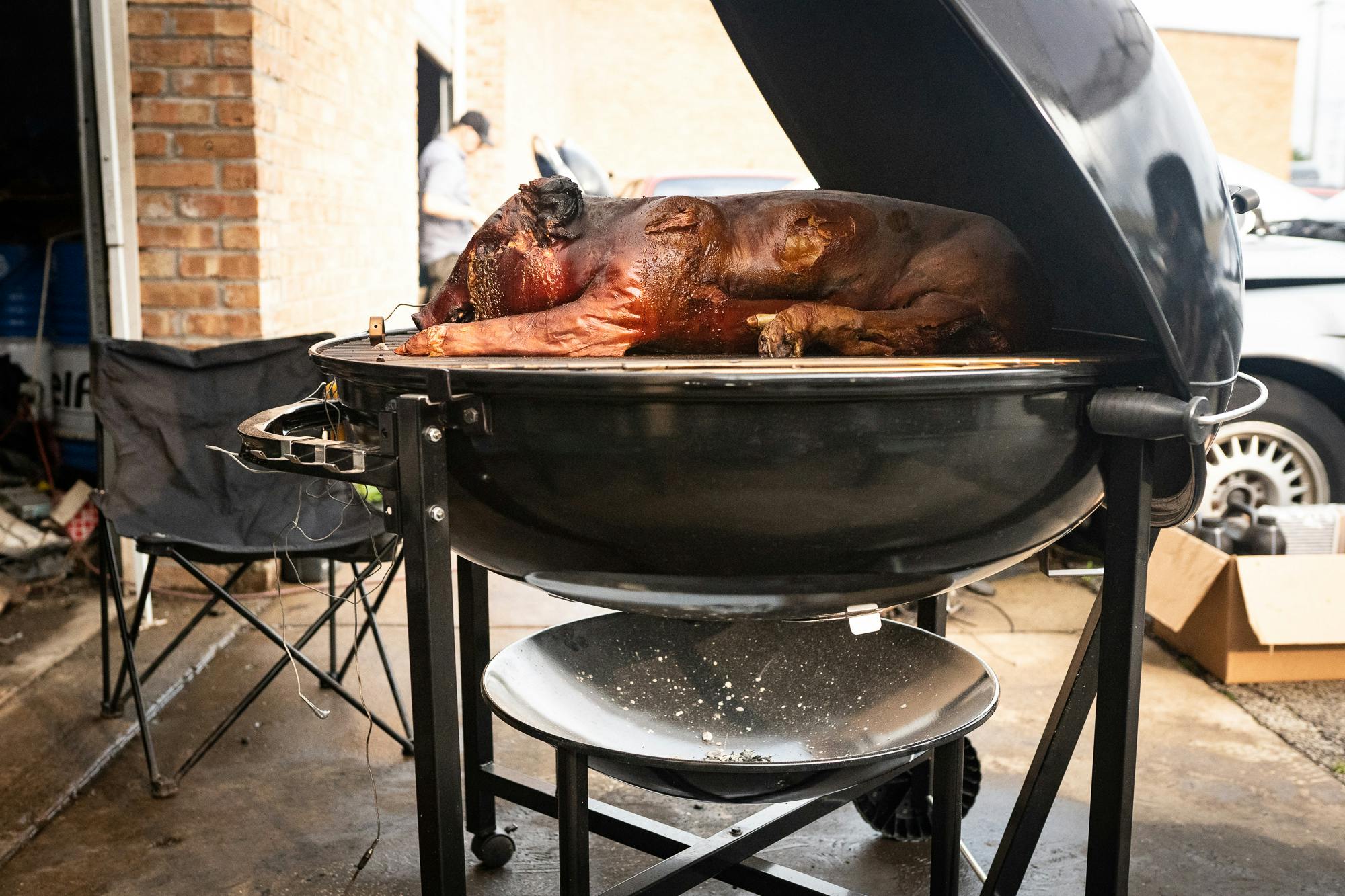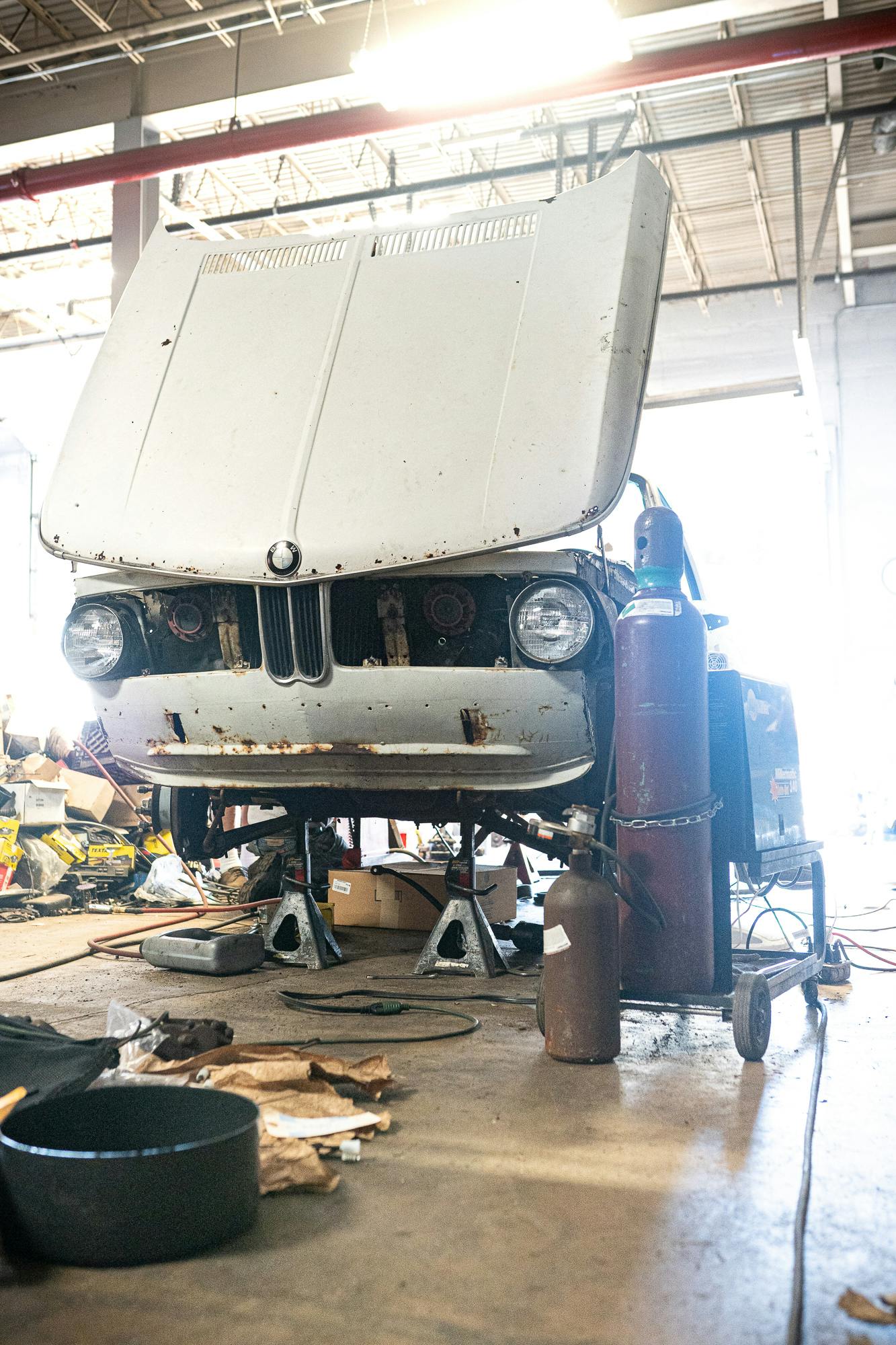Smithology: Your trailing arms are too short to box with Carl

Welcome back to The Weissrat Chronicles, Sam Smith’s tale of dragging an $1800 BMW 2002tii back to life in off-hours and weekends, when he’s not busy testing new cars for Hagerty. This is the fifth installment in the series, with the chapters best enjoyed in order: One, Two, Three, Four, Five, Six, and Seven. Shorter updates live on Instagram, at @thatsamsmith and the hashtag #weissrat. —Ed.
This is a story about trailing arms.
Midday Saturday, Carl took the trailing arms outside and began to wire-brush them clean. This struck me as odd.
“There was this thing,” I said, “where, several weekends ago, in this very shop, I kept trying to make parts of this car nicer. Ben made fun of me for it. Because the rest of the car is so … crap.”
“He was right,” Carl said flatly, still brushing.
“But you are making those arms … nicer.”
“I am.”
My brow furrowed. “I don’t understand.”
Warm smile. “You probably shouldn’t.”
Know the rear suspension of a 2002, you know half the car and much of BMW in the latter half of the last century. In 1957, attempting to stay afloat in the long wake of World War II, the Bavarian Motor Works launched a four-seat, motorcycle-engined, 20-hp microcar called the 600. The rear suspension featured two triangular control arms hung on the back of the frame, their mounts canted toward the outside of the car. Drive came from a Volkswagen-ish transaxle and two flexibly jointed halfshafts.

The arrangement was called semi-trailing arm—the “semi” represents the cant—and while it was far from novel, it was cheap, durable, and effective. Semi-trailing suspension is effectively a cross between the good bits of both a swing axle and a standard trailing-arm setup, with fewer drawbacks than either layout. The basic idea carried on under new BMWs for decades, from the company-saving 1500 sedan of 1962 to the 2002 and the epoch-defining 3.0 CSL. The first two M5s featured semi-trailing arms, as did the first M6 and the first M3. The M1 supercar didn’t wear them, but the Z3 coupe and convertible did. The design evolved along the way. Geometry was updated for improved wheel control. Subframes and bearing carriers were changed to serve a number of masters, from torsional rigidity to the ever-rising grip of modern road tires. In the end, however, the concept worked well with the 1500’s 80 hp and 165-section rubber, and it was good enough for the 315 hp and 245 rear meats of a 2001 Z3 M Coupe.
Plus—and this is the kicker—it was fun on a bun.
Not that there weren’t drawbacks. A semi-trailing arm can show a tire a relative heap of suffering. The design generally allows camber—a tire’s vertical tilt—to change drastically with compression or droop, altering cornering and braking ability on the fly. On top of that, under braking or sudden throttle lift, bushing compliance can cause the rear wheels to abruptly steer a little—toe change—toward the outside of the car. In normal driving, a dab of that brake/lift steering effect can help point a car into a corner. As forces rise, however, that effect blooms, and the rear wheels can try to steer the fronts.
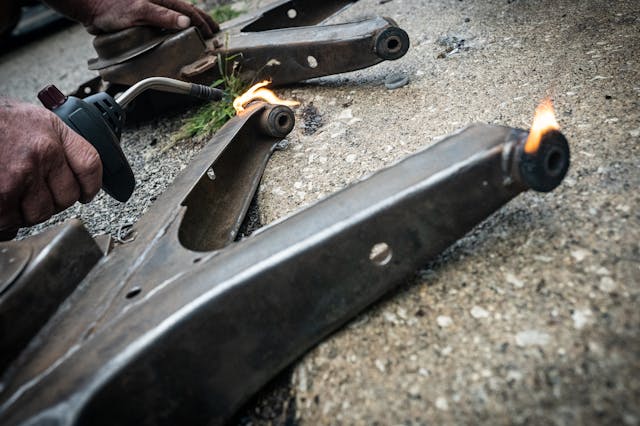
Loose, as they say in NASCAR. Dorifto, in Japan. Or maybe just Oh Hell, Martha, Timmy Wrapped the M5 Around a Telephone Pole. (Again.)
Naturally, the world spun up answers to this problem. Modern multilink rear suspensions are far more grippy and forgiving. Still, that weirdly vibrant feel of the semi-trailing arm meant something to the faithful. You fired an old BMW into a corner, you felt the thing vivid in your hands, fizzy and alive.
Which brings us back to my half-dead pile of crap.

By the Saturday morning of that third weekend in Chicago, Carl and Mark were still on West Coast time. They had flown in from San Diego Friday night, at which point they cannoned into the shop, met the small crowd gathered for work on the car, evaporated gallons of beer, and then caught a ride to a nearby hotel. They reappeared at 11:30 Saturday morning.
Mark said he was not hung over. Then he walked over to my tii and hit the floor pan repeatedly with a large mallet for no reason while cackling. At that point, I knew he was not hung over, but I was also not exactly not hung over, so I mostly just stood there and blinked slowly while trying to figure why a 60-something professional TIG welder from California seemed intent on yelling directly into the gaping maw of my all-consuming headache.
It was probably because he is my friend.
Related note: I go road racing with these people. Ben (Chicago shop owner, engineer for our little team), Carl (owns a BMW shop in California, excels at team parties), Mark (owns the car, excels at metal fabrication and general hoots/hollers). Along with a rotating cast of around 10 other friends, we campaign a 1972 2002 in a West Coast B-sedan club series. When the car does not do well, it is generally because I have failed as a driver, or because the night prior contained obscene quantities of beer. Paradoxically, said beer is also the reason we have won races, and if you do not understand that sentence, then you have never been sucked into the money-eating whirlpool of joy and illogic that is zero-stakes club racing.

Walking into the shop, Carl dropped a large duffel on the floor. “TSA looked at me funny,” he said.
Carl is also a 60-something Californian. He has a PhD in geology and restores vintage BMWs for a living while wearing shorts. When he is really busy or simply having a great time, his white hair points straight out, like the patterns in a Tesla coil.
“I got the secondary inspection at the airport. For the meat backpack.”
I thought for a moment. “They didn’t ask about the large steel suspension parts?”
“Oh no, those were in a checked bag.”

From the depths of the duffel arose two unrusty and ex-California 2002 trailing arms, to replace my car’s terminally rotten pieces. Carl’s backpack, unloaded into the fridge the night before, had carried across the country 40 pounds of raw California tri-tip, aimed at the shop grill on Saturday night. (A 40-pound raw pig also sat in the building, tapped for that grill, but that’s a story for another time.)
The welding began early. Quick and dirty floor and subframe-mount repair, triaging the car away from structural failure, to the plan. Mark fired up Ben’s TIG machine. Matt McGinn, in from Connecticut, grabbed the MIG gun. Matt is ex-Army in both resume and profanity, and he runs a restoration shop. Over the course of the weekend, welding almost nonstop, he and Mark formed a strange sort of bond. The two of them would yell increasingly creative four-letter words on something like the hour, or whenever the shop breaker tripped, or if the weather shifted, or if anything happened at all, really. Maybe the smell of melting MIG wire does something to your head.
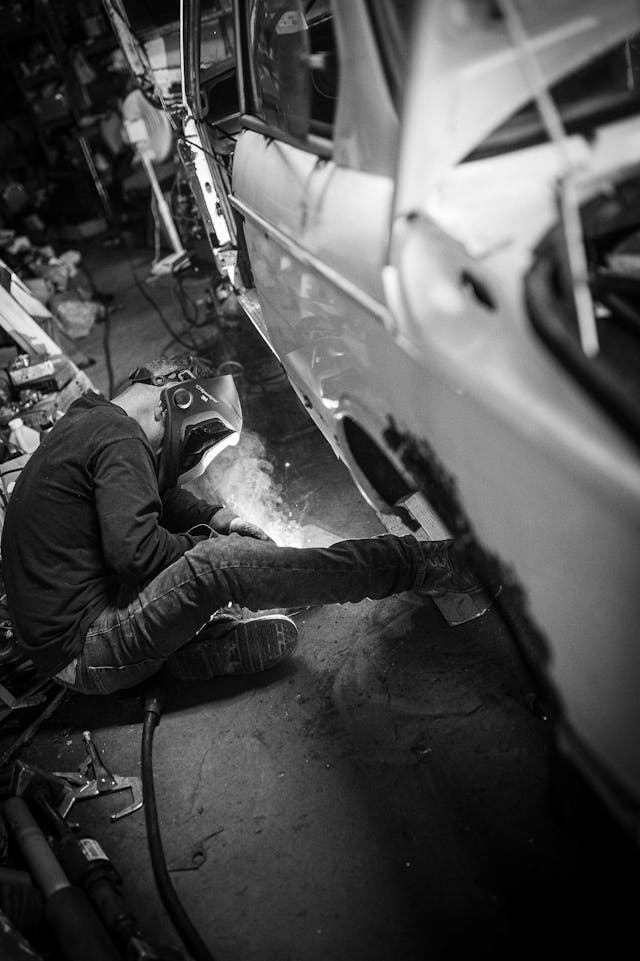
That afternoon, Matt was in the car, walloping the rear floor with a hammer while merrily shouting obscenities. It seemed like a good time to thank him for coming to town.

He paused. “Are you kidding? I love this. I mean, where else would I be—at my daughter’s soccer game? Which is great, but like, I’m not getting self-actualized. Where am I on the f***in’ pyramid?”
As if on cue, Carl walked up holding a now-clean trailing arm. Mark set down his TIG wire, then walked behind the car and jigged the arm’s bushing holes into a large piece of allthread. Then he began test-fitting a steel patch inside the arm.
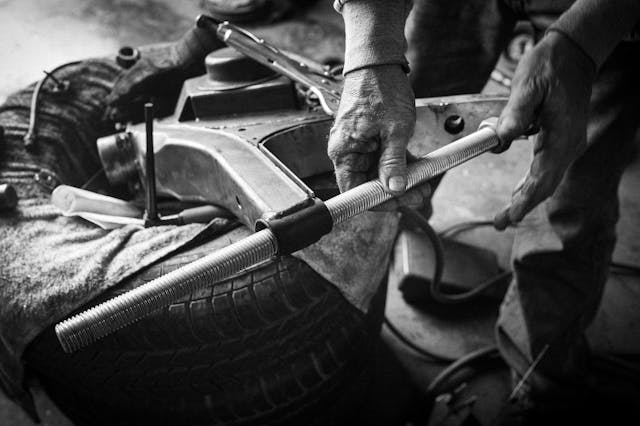
“Wait,” I said. “What’s going on?”
“The allthread keeps it from warping under weld heat,” Carl said.
“No, the patch?”
A standard 2002 trailing arm has two legs, each leg C-shaped in cross-section. The arms on a 2002tii are boxed for strength, the C’s open end closed off. Most people now view this reinforcement as nice but unnecessary, classic German overengineering—a ’72 2002 wore 4.5-inch wheels from the factory and produced 113 hp, while the performance model, the tii, offered 5-inchers and 130. The delta wasn’t exactly a Hemi swap and drag slicks, but that’s ’70s Germans for you. Some bits of a 2002 were built cheaply, while others were comically overdone and last forever.

Mark flipped the mask up. Wide eyes for effect. “It’s a tii!” Mask down again. “Needs the box.”
“He made patches,” Carl said, straight face.
“It’s a tii!” Mark repeated, like a broken record, still welding.
“It’s not a museum piece,” I said. “Are you joking?”
“No,” said Carl.
On a race car wearing factory arms, the tii reinforcement genuinely helps arm stability—but then, Mark’s ’72, on Hoosier R7 race tires, can pull around 1.5 g at max lat. My car was about as likely to meet a full g as it was to meet the Dalai Lama. I considered opposing themes for a second, then went on to something else. Past a certain point, when your companions are busily grilling a combined 80 pounds of meat, you stop asking questions.
Once Mark had boxed both arms, Carl handed them to Paul. He painted them and installed new brake lines. Pretty. Not unsatisfying. In the end, though, as the paint was drying, Paul’s face wrinkled, concerned. He rolled a wheel bearing with a finger, then looked at me.
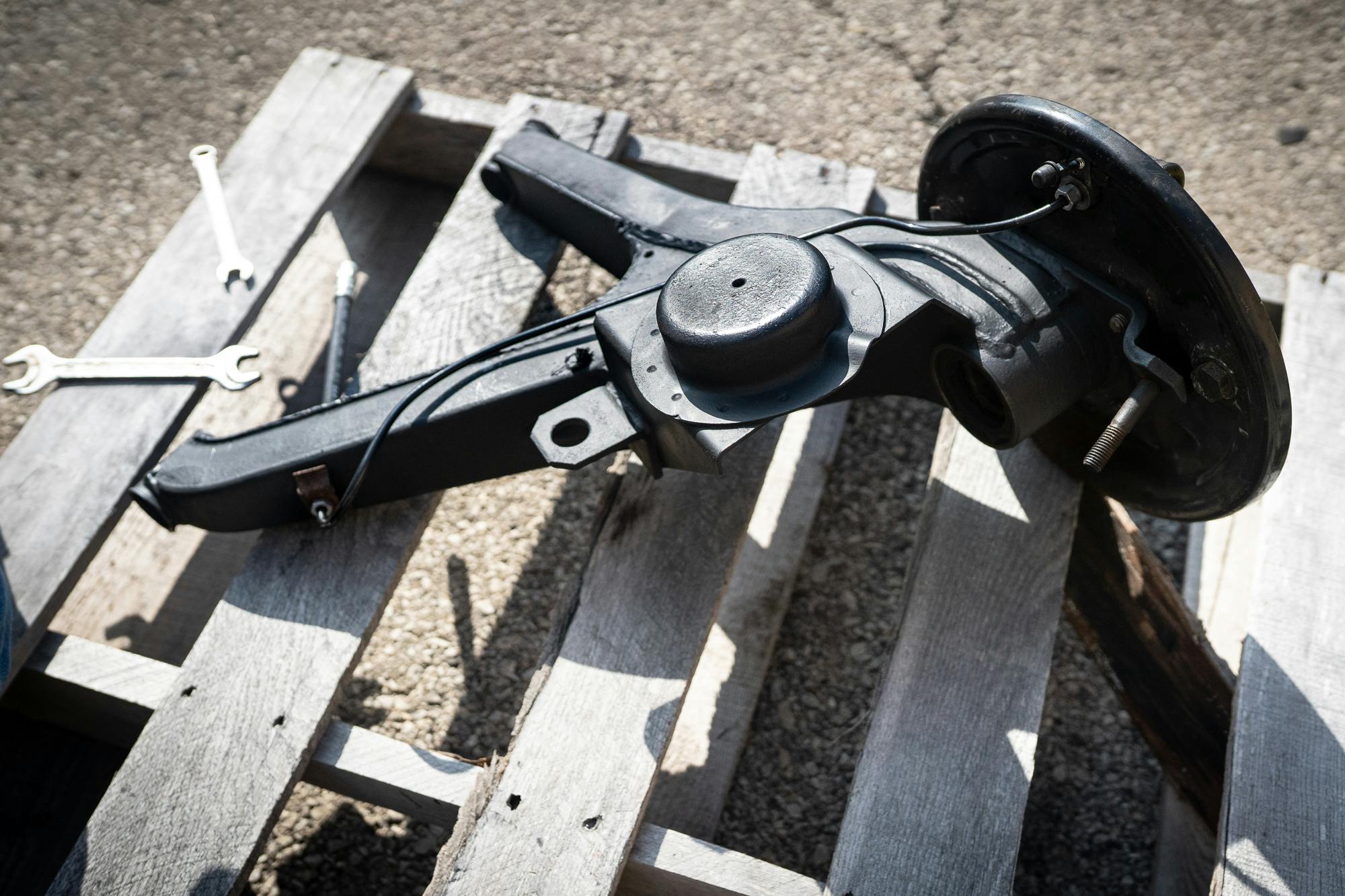
“I don’t like the way this feels.”
The inner race moved oddly, as if its balls had been gnawed by rats. I called over Carl, asked if he brought new bearings. He was nonplussed.
“Oh, that? That’s fine. I looked at them—this car, it won’t matter.”
Two lifetimes of old-BMW experience between the two men. Paul raised an eyebrow. Carl noticed.
“Don’t worry about it.”
Ben walked up, glanced at the arm. At that moment, his shop held enough 2002s for a parade.
“That?” he said, incredulous. “It’s fine. Those bearings are huge.”
Carl said something about having seen maybe a handful of worn-out 2002 rear bearings in his entire career. I briefly contemplated the thousands of cars that might pass through a Southern Cal BMW shop in more than 30 years.
“It’ll smooth out with load,” he said, with a dismissive wave. “They rarely even get noisy. Way too big for the job.”
“What about the race car?” I asked. “Surely they wear, with R7s … ?”
“Oh, hell no. Not the rears, at least. Start with new ones, they don’t budge. Last forever.”

Ben chuckled. Carl stepped outside to answer his phone. Paul assembled the rear brakes on each trailing arm, then installed the stub axles. When he was done, an hour or so later, he showed me the axle. Still dubious.
“Feel that. See?”
The bearing wasn’t much better. “I dunno, man. I would normally think twice, but these guys have done this a billion times more than you and me put together.”
He poked at the arm for a bit, frowning, then shrugged and went to smoke a cigarette.
I stood in that corner of the shop for a minute, watching sparks cascade from the tii’s interior, thinking about the last time I slid a 3.0 CSL around Laguna Seca.

“Build quality,” I heard my voice say, softly and to no one in particular.
What a loaded phrase. And how remarkable our obsession with measurable value. You work on the car, as a fine man once wrote, and the car works on you. In a fluid world, overbuilt objects are a sort of testament. That testament only grows more interesting when you begin to consider the process and the whys of compromise. How a company can design a device for a certain type of person, the variables so ideal for a given moment that the appeal outlasts both the product and, in a lot of ways, the company itself. For better or worse, the BMW of now is not the BMW of old. Same for German cars, period. Mercedes-Benz ads toot a lot about The Best or Nothing, and if you drive a ’50s Gullwing, that line seems to flirt with reality. Then you learn about chronic door rust on the early-2000s S-Class or the maintenance cost of a late-model C63, and the idea backs up a little. Quality becomes fungible, negotiable for the day. But the appeal never shrinks.
It says something, after all, when an individual decides to do good work. Even more when a person makes that choice without much in the way of resources. A few pieces of steel, say, and a tired old car where a few select parts really matter, and a problem, however simple, to be solved.
To be continued…
Appendix 1: Work Accomplished in Weekend Four, Project Weissrat
- Trailing-arm bushings replaced
- Trailing arms cleaned/painted
- Doors removed
- Right rocker reinforcement-tube welding completed
- Right-floor rust repair (mostly) completed
- Right subframe-mount repair completed
- Left rocker reinforcement tube installed, plug welded to sill
- Left floor repair (mostly) completed
- A-pillar vertical reinforcement tube welding begun
- Brake master cylinder replaced
- Front rotors replaced
- Right caliper replaced
- Subframe mounts replaced (2X)
- New hard brake lines bent/installed, rear suspension
- New flexible brake lines installed
- New hard front brake lines bent/installed, front struts
- Windshield removed
- Rust hole under windshield cleaned, welded shut
- Windshield reinstalled (hasty, five minutes, not permanent)
- Car floor hit with a hammer, by Mark, for no reason, while laughing (10X)
- Mark’s weight drank in beer, by Mark, for “welding reasons” (1X)
- Doors reinstalled
- Brake drums painted hi-viz yellow by Paul for the sole purpose of irritating Sam
- Open ends of rocker reinforcement tubes capped with steel, welded shut
- Forty-pound pig cooked on house Weber Ranch Kettle grill
- Car pushed back into storage in back of shop (1X, slowly, after beer).


